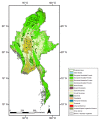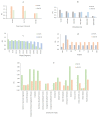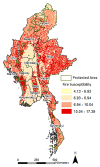Factors controlling vegetation fires in protected and non-protected areas of myanmar
- PMID: 25909632
- PMCID: PMC4409334
- DOI: 10.1371/journal.pone.0124346
Factors controlling vegetation fires in protected and non-protected areas of myanmar
Abstract
Fire is an important disturbance agent in Myanmar impacting several ecosystems. In this study, we quantify the factors impacting vegetation fires in protected and non-protected areas of Myanmar. Satellite datasets in conjunction with biophysical and anthropogenic factors were used in a spatial framework to map the causative factors of fires. Specifically, we used the frequency ratio method to assess the contribution of each causative factor to overall fire susceptibility at a 1km scale. Results suggested the mean fire density in non-protected areas was two times higher than the protected areas. Fire-land cover partition analysis suggested dominant fire occurrences in the savannas (protected areas) and woody savannas (non-protected areas). The five major fire causative factors in protected areas in descending order include population density, land cover, tree cover percent, travel time from nearest city and temperature. In contrast, the causative factors in non-protected areas were population density, tree cover percent, travel time from nearest city, temperature and elevation. The fire susceptibility analysis showed distinct spatial patterns with central Myanmar as a hot spot of vegetation fires. Results from propensity score matching suggested that forests within protected areas have 11% less fires than non-protected areas. Overall, our results identify important causative factors of fire useful to address broad scale fire risk concerns at a landscape scale in Myanmar.
Conflict of interest statement
Figures





Similar articles
-
Spatial distribution of forest fires and controlling factors in Andhra Pradesh, India using SPOT satellite datasets.Environ Monit Assess. 2006 Dec;123(1-3):75-96. doi: 10.1007/s10661-005-9122-4. Epub 2006 Oct 20. Environ Monit Assess. 2006. PMID: 17054011
-
Landscape development, forest fires, and wilderness management.Science. 1974 Nov 8;186(4163):487-95. doi: 10.1126/science.186.4163.487. Science. 1974. PMID: 17790369
-
Grazers, browsers, and fire influence the extent and spatial pattern of tree cover in the Serengeti.Ecol Appl. 2009 Jan;19(1):95-109. doi: 10.1890/07-1954.1. Ecol Appl. 2009. PMID: 19323175
-
Effects of fire on woody vegetation structure in African savanna.Ecol Appl. 2010 Oct;20(7):1865-75. doi: 10.1890/09-0929.1. Ecol Appl. 2010. PMID: 21049875
-
Altered cyclone-fire interactions are changing ecosystems.Trends Plant Sci. 2022 Dec;27(12):1218-1230. doi: 10.1016/j.tplants.2022.08.005. Epub 2022 Oct 13. Trends Plant Sci. 2022. PMID: 36244895 Review.
Cited by
-
Landscape characteristics influence ranging behavior of Asian elephants at the human-wildlands interface in Myanmar.Mov Ecol. 2022 Feb 5;10(1):6. doi: 10.1186/s40462-022-00304-x. Mov Ecol. 2022. PMID: 35123584 Free PMC article.
-
Does the Establishment of Sustainable Use Reserves Affect Fire Management in the Humid Tropics?PLoS One. 2016 Feb 17;11(2):e0149292. doi: 10.1371/journal.pone.0149292. eCollection 2016. PLoS One. 2016. PMID: 26886207 Free PMC article.
-
Contemporary forest loss in Myanmar: Effect of democratic transition and subsequent timber bans on landscape structure and composition.Ambio. 2021 Apr;50(4):914-928. doi: 10.1007/s13280-020-01414-9. Epub 2021 Mar 7. Ambio. 2021. PMID: 33677806 Free PMC article.
-
Spatial variations in vegetation fires and emissions in South and Southeast Asia during COVID-19 and pre-pandemic.Sci Rep. 2022 Oct 29;12(1):18233. doi: 10.1038/s41598-022-22834-5. Sci Rep. 2022. PMID: 36309590 Free PMC article.
-
COVID-19's impact on the atmospheric environment in the Southeast Asia region.Sci Total Environ. 2020 Sep 20;736:139658. doi: 10.1016/j.scitotenv.2020.139658. Epub 2020 May 25. Sci Total Environ. 2020. PMID: 32492613 Free PMC article.
References
-
- Nepstad DC, Verssimo A, Alencar A, Nobre C, Lima E, Lefebvre P, et al. Large-scale impoverishment of Amazonian forests by logging and fire. Nature. 1999;398:505–508. 10.1038/19066 - DOI
-
- Lambin EF, Geist HJ, Lepers E. Dynamics of land-use and land-cover change in tropical regions. Annu Rev Environ Resour. 2003;28(1):205–241. 10.1146/annurev.energy.28.050302.105459 - DOI
-
- Cochrane M. Tropical fire ecology: climate change, land use and ecosystem dynamics. 1st ed Springer-Verlag Berlin Heidelberg; 2009.
-
- DeFries R, Rudel T, Uriarte M, Hansen M. Deforestation driven by urban population growth and agricultural trade in the twenty-first century. Nat Geosci. 2010;3:178–181. 10.1038/ngeo756 - DOI
-
- Stolle F, Chomitz KM, Lambin EF, Tomich TP. Land use and vegetation fires in Jambi Province, Sumatra, Indonesia. For Ecol Manage. 2003;179:277–292. 10.1016/S0378-1127(02)00547-9 - DOI
Publication types
MeSH terms
LinkOut - more resources
Full Text Sources
Other Literature Sources

